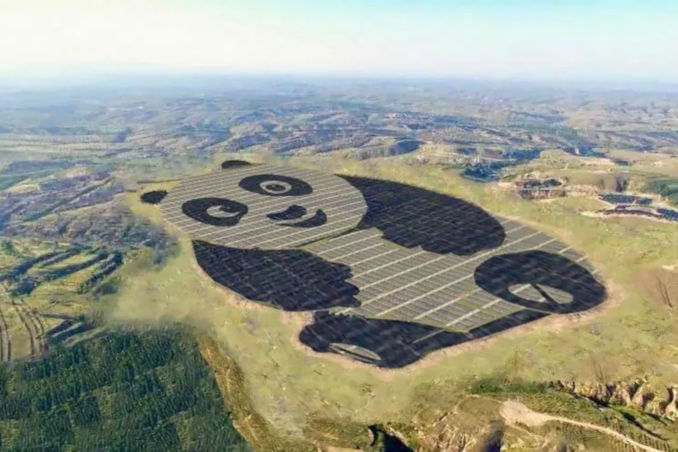

The panda solar farm in Datong, China. (Photo: China Merchants New Energy/Panda Green Energy)
In 2023 China produced 60% of the world’s electric vehicles, 98% of the world’s electric buses and two-thirds of all the world’s wind and solar projects. Its workers installed more solar panels than they had in the previous three years combined, nearly twice as much as the rest of the world combined.
These figures account for large solar farms that feed directly into the grid. Small solar farms, which make up 40% of China’s solar capacity, make solar power production totals in China much higher. China’s growth in wind power also increased in 2023, faster than in any country except the United States.


The panda solar farm in Datong, China. (Photo: China Merchants New Energy/Panda Green Energy)
Electric vehicles
Chinese EVs now cost $10,000-$15,000 per car on the world market. A few reasons for the drastic price drop of 50% is that Chinese companies are producing their own lithium batteries, which they can produce 51% cheaper. Chinese government subsidies for EVs have risen from $76.7 million in 2018 to $809 million in 2023.
Capitalist industry based in the U.S. is unable to produce and sell EVs at such low prices, and its auto manufacturers are still heavily reliant on expensive cars that burn fossil fuels. The U.S. government is raising tariffs on Chinese electric vehicles (now at 25%) to 100% starting Aug. 1. The European Union plans to increase tariffs up to 48% sometime this year.
China supplies 60% of global EV batteries and much of the lithium-ion cell components. “China’s Batteries Are Now Cheap Enough to Power Huge Shifts,” meaning the shift away from combustion engines, is the title of an article in the Bloomberg newsletter. (tinyurl.com/yc74z7ua) This year the U.S. government will increase the tariffs on Chinese batteries up to 25%. It plans to also impose stiff tariffs on semiconductors and raw materials used to make EV cars. (tinyurl.com/7e2szfzv)
Chinese innovations: people before profit
Chinese workers and scientists have created the first seawater electrolysis system that produces hydrogen directly from ocean water using offshore wind power, a renewable energy source. Hydrogen is a clean, versatile fuel that traditionally could only be produced using an expensive high-energy process to first desalinate ocean water.
Chinese researchers have designed a material that reflects the sun’s rays and can be welded together in planks. When attached to the outside surface of buildings, the planks reduce temperatures inside then, cutting down the need for air conditioning and reducing carbon emissions. The plank material is made of gelatin and DNA from organic matter, which can be made biodegradable and converts ultra-violet (UV) radiation into visible light. This plank technology opens the way for further innovative, sustainable cooling materials.
At the end of 2023, China had produced 1.27 million registered drones; these are huge pilot-free cargo planes that can carry a 500-kilogram (1,100-pound) load as far as 500 kilometers (310 miles) with a maximum range of 1,800 kilometers (1,118 miles). They can be used for transportation, fire and rescue teams and flood control and disaster relief work. They are 70% quicker and 30% cheaper than conventional cross-sea transport.
U.S. corporations are threatened by all the Chinese innovations being developed and transforming the world. They know that when privately owned capitalist industries have monopoly control of an industry, their only goal is to maximize profits.
Land back now!
China just completed the largest floating solar farm in the world on top of an old coal plant! In contrast, U.S. industries trespass on sovereign Indigenous land to construct solar plants, wind farms, power transmission lines and copper mines for lithium extraction for electric batteries—without consulting with leaders of the Indigenous nations and tribes.
U.S.-based industries are still heavily reliant on profits from the fossil fuel economy. The U.S. government, while beginning to invest in renewable fuels, is moving in on Native reservations and sacred lands.
The Colorado River Indian Tribes (CRIT), which includes the Mohave, Chemehuevi, Hopi and Navajo Nations, is suing the Bureau of Land Management for constructing a solar plant on 4,000 acres of their ancestral homelands. They have been fighting the plans since 2006. The CRIT explained they are not against solar power, but they object to not being consulted—and because of the effects it will have on the ecosystem, cultural resources, groundwater and the Colorado River. (tinyurl.com/5n8p32ta)
In February, members of the San Carlos Apache Nation in Arizona asked that work stop on the $10 billion construction of a copper mine on the reservation’s sacred territory. Tribal member Verlon Jose said, “We do not disagree with renewable energy, we are for renewable energy. You know what the fix to this issue is? They could have rerouted it. But they didn’t listen.” (Washington Post, March 4)
Native activist, ecologist and author Winona LaDuke added, “In the endless pursuit of energy, once again, Native people are in the eye of the storm.” She calls mines and other projects that could imperil tribal sovereignty “the next Standing Rock.”
The epic struggle of the Palestinian people against the full weight of U.S. imperialism and…
The following report comes from the Bronx Anti-War Coalition organizers on a protest held in…
In the Canadian federal elections held on April 28, the Liberals won with 169 seats…
The following is Part 2 of a talk given by the author to a meeting…
Boston Students, professors and workers are confronting the Trump administration’s fascist crackdown at universities across…
Philadelphia Within days of Swarthmore students reviving a pro-Palestinian encampment on April 30, police arrested…